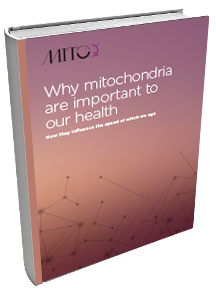MitoQ Proprietary Antioxidant Selected For Study By National Institute of Aging’s Interventions Testing Program

MitoQ, the world’s first antioxidant formula demonstrating ability to penetrate mitochondria in order to deliver antioxidants in meaningful levels, has been selected for the USA’s National Institute of Aging’s (NIA) Interventions Testing Program (ITP) — an internationally recognized anti-aging testing program funded by the US Government — reports Randy Strong PhD, a Professor of Pharmacology, Director of the NIA Aging Interventions Testing Center, and Director of the Nathan Shock Center of Excellence in the Biology of Aging Barshop Institute for Longevity and Aging Studies at the University of Texas Health Science Center at San Antonio. Dr. Strong is an NIA spokesperson and principal investigator for the ITP Research Program.
According to the United Mitochondrial Disease Foundation and the National Institute of Neurological Disorders and Stroke, mitochondria (singular mitochondrion) are tiny subunits present inside every cell of the human body except red blood cells, from the skin to the deep internal organs, and particularly concentrated in organs that require the most energy, like the brain, heart, and liver. Mitochondria’s main role transforming food and oxygen that enter the cells into useful energy, with almost all of the energy the body needs for daily life and growth and they are responsible for creating more than 90 percent of the energy needed by the body to sustain life and support. The term mitochondrion derives from the Greek mitos (“thread”), and chondrion (“granule” or “grain-like”). More technically, mitochondria are double membrane-bound organelles — specialized subunits within cells with a specific function that are found in most eukaryotic cells, that is: cells that have a nuclear envelope, cytoplasmic organelles, and a cytoskeleton.
Mitochondria range in size from 0.5 to 1.0 m in diameter, with considerable variations observable in the structure and size of the organelle, and are sometimes described as “the powerhouses of the cell” because they generate most of the cell’s supply of adenosine triphosphate (ATP), used as a source of chemical energy, and are involved in divers other tasks, such as signaling, cellular differentiation, and cell death, as well as maintaining control of the cell cycle and cell growth.
Mitochondrial disease primarily affects children, but adult onset is becoming more and more common, and there is a broad spectrum of metabolic, inherited and acquired disorders in adults in which abnormal mitochondrial function has been postulated or demonstrated. Symptoms of mitochondrial disease may include diminishment or loss of motor control, muscle weakness and pain or exercise intolerance, gastrointestinal disorders, swallowing difficulties, poor growth, fatigue, lack of endurance, poor balance, cardiac disease, liver disease, diabetes, respiratory complications, seizures, visual/hearing problems, lactic acidosis, developmental delays, skeletal muscle abnormalities, and susceptibility to infections, nervous system impairment.
The National Institutes of Health (NIH) notes that while there is no specific treatment for any of the mitochondrial myopathies, physical therapy may extend the range of movement of muscles and improve dexterity, and vitamin therapies such as riboflavin, coenzyme Q, and carnitine (a specialized amino acid) may provide subjective improvement in fatigue and energy levels in some patients.
 “Selection for the program validates a widening view within the research community that MitoQ confers anti-aging benefits by delivering the body’s natural antioxidant CoQ10 to mitochondria, optimizing mitochondria and its benefits,” explains MitoQ Ltd. CEO Greg Macpherson. “Until now, other sources of CoQ10 were unable to infiltrate the mitochondria and thus make a tangible difference.”
“Selection for the program validates a widening view within the research community that MitoQ confers anti-aging benefits by delivering the body’s natural antioxidant CoQ10 to mitochondria, optimizing mitochondria and its benefits,” explains MitoQ Ltd. CEO Greg Macpherson. “Until now, other sources of CoQ10 were unable to infiltrate the mitochondria and thus make a tangible difference.”
Research has shown that aging, and its associated health issues and lower energy levels, is linked to decline in mitochondrial function. “Flooding the mitochondria with antioxidants improves the level of energy available to a cell and reduces free radical-associated cell damage,” Mr. Macpherson noted. “By improving their function while reducing cell damage, we may slow down the aging process keeping all of our organs and body healthier and younger for longer. The NIA is part of the US National Institute of Health, an organization that invests over $30 billion per annum into health research. MitoQ was chosen for the testing program because it shows significant potential to delay or decelerate the aging process and improve general health.”
MitoQ’s Mitochondrial Science
MitoQ is described as a new type of antioxidant that protects mitochondria, with mitochondrial dysfunction now understood to be present in over 200 diseases and conditions that range from diabetes and liver disease to Alzheimer’s and heart disease.
Unlike many new drugs, MitoQ has been tested for safety in numerous clinical trails with humans. Since its development in the late 1990s, researchers have tested MitoQ’s ability to decrease oxidative damage in mitochondria. MitoQ is one of the most-studied mitochondrial-targeted antioxidants. According to the manufacturer, research has shown that after oral administration, MitoQ rapidly accumulates in mitochondria-rich tissue such as the heart, brain, skeletal muscle, liver, and kidney and supports a range of conditions associated with oxidative stress.
Biochemical reactions generate free radicals as by-products, and mitochondria generate a lot of free radicals, so need a constant supply of antioxidants to keep these free radicals in check. While free radicals do have some important benefits when present in the right numbers, overproduction of free radicals can lead to severe damage of the cell. MitoQ is formulated to get past the inner mitochondrial membrane to end up deep within the mitochondria. It releases the active form of coenzyme Q10 right at the major site of free radical production, reduce oxidative stress.
MitoQ is produced by binding a form of Co Q10 called ubiquinone, to a fat soluble, positively charged molecule. This positively charged molecule is able to flow directly into the mitochondria and through the normally impermeable inner membrane to end up deep inside the mitochondria — exactly where it is needed the most, at concentrations several hundred-fold higher than if it just stayed in the blood. A reaction inside the inner membrane converts the ubiquinone in MitoQ into ubiquinol, the antioxidant and active form of Co Q10.
The company says that supplementing regularly with their product reenergizes cells so they can self-repair, work optimally and correct oxidative stress imbalances, thereby helping to reduce free radical damage and slow the aging process.
MitoQ was discovered by scientists in an Otago University laboratory in 2000 searching for compounds that could treat liver disease and brain disease and focused especially on determining correct levels of oxidative stress in cells and the energy imbalances that occur in these diseases. Among their findings was a way to support mitochondria which, in turn, had beneficial effects across the whole cell and slowed down the processes normally associated with aging. Over a decade later, 30 million dollars of research and 180 published research papers, globally patented MitoQ is available commercially.To date, there are over 200 published research papers globally that detail MitoQ’s effect. Two human trials are currently underway with four more scheduled for 2016.
Results of the ITP trial will be available in 2020 and will be published in numerous scientific journals such as Nature, Journals of Gerontology and Aging Cell.
 In the meantime, MitoQ also offers a free ebook on Why Mitochondria Are Important to Our Health and how they influence the speed at which we age.
In the meantime, MitoQ also offers a free ebook on Why Mitochondria Are Important to Our Health and how they influence the speed at which we age.
To learn more about mitochondria and the effects of MitoQ, view the video and web site: https://www.youtube.com/watch?v=Udrqdof9wog
There are currently four MitoQ products distributed internationally; MitoQ skin serum, MitoQ 5mg Supplement, MitoQ Heart Supplement and MitoQ Blood Sugar Supplement. For more information, visit:
https://www.MITOQ.com
Sources:
MitoQ
National Institute of Aging
NIA Aging Interventions Testing Center
University of Texas Health Science Center at San Antonio
United Mitochondrial Disease Foundation
National Institutes of Health National Institute of Neurological Disorders and Stroke






